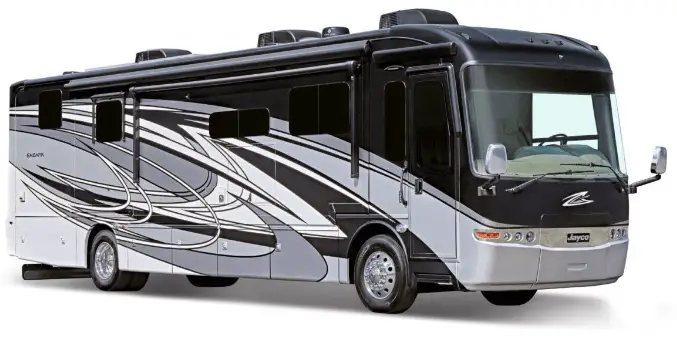Jayco Embark 2023 Towing Behind Your Motor Home User Manual
Towing Behind Your Motor Home
Caution
Do not install a frame equalizing type hitch on your motor home.
Towing will affect vehicle handling, durability, and fuel economy. Exceeding any of the listed weight ratings will result in unacceptable overall vehicle performance. Your safety and satisfaction require the proper use of the correct equipment.
For maximum pulling load and vertical tongue weight, refer to the label located on the rear hitch. A hitch bar of appropriate strength and steel should be selected to meet the capacities of the towing receptor.
Always use safety chains between the motor home and the towed trailer or vehicle. Cross the chains under the tongue and allow for slack when turning corners. Connect the safety chains to the vehicle frame or hook retainers. Never attach the safety chains to the bumper.
Before descending a steep or long grade when towing a trailer or vehicle, reduce speed and shift the motor home into a lower gear to control vehicle speed. Avoid frequent or prolonged brake applications, which can cause overheating or brake failure. By definition, the GCWR is “the maximum total weight rating allowed for a vehicle and any attachment, such as a trailer or towed vehicle. To determine the total allowable weight for a towed item, subtract the GVWR from the GCWR.
Towing and Braking Label
Warning
The total weight of your motor home and any trailer or vehicle towed by it must not exceed the GCWR. Do not assume that you can tow a vehicle that happens to be within the capacity of the hitch. By doing so, you may exceed the total GCWR of the motor home.
- The total weight of your motor home (including cargo, passengers, fluids, etc.) in addition to the vertical (tongue) weight must not exceed the GVWR and/or any GAWR. Once again, do not assume that you can tow a trailer or vehicle that happens to be within the vertical (tongue) weight capacity of the hitch. By doing so, you may exceed the GVWR and/or GAWR of the motor home.
- Your motor home chassis braking system is rated for operation at GVWR, NOT GCWR. Any trailer or vehicle being towed by your motor home must have adequate brakes as required by all state (or province) and local regulations for towing with your motor home, including areas you may be traveling through. Failure to follow the towing guidelines may result in property damage or injury. In addition, a separate supplemental braking system must be installed if the towed trailer or vehicle meets or exceeds the minimum weight determined by the chassis manufacturer (this minimum weight rating will vary by chassis and chassis manufacturer). Contact your dealer for assistance in determining whether a separate braking system is recommended for your towing and traveling safety. Failure to follow these instructions will create a safety hazard and may result in an accident.
Maintenance
Keep the hitch clean along with your general frame maintenance. At the beginning of the season, and monthly or thereafter, clean the inside of the receiver tube with a wire brush and spray with a silicone spray. Always remove the utility mount from the receiver when it is not in use. This will help prevent the utility mount from rusting to the tube. Periodically check the bolts for tightness. They need to be torqued to the proper setting (refer to your Chassis Guide). Refer to the chassis manual for detail on hitch specifications and towing guidelines.
Safe Haul System
Your motor home is equipped with a factory-installed “Safe Haul” system. This is a supplemental braking system used when a vehicle is being towed behind the motor home. The motor home’s air supply is utilized to operate brakes on both the towed vehicle and the motor home providing proportional braking between the coach and the tow vehicle. This will reduce the motor home braking distance and prevent a runaway vehicle should it become disconnected from the coach. Brakes are only applied to the tow vehicle when the brakes on the motor home are applied. An air hose coupling (in the vicinity of the electrical harness connection) located at the rear of the motorhome supplies the air pressure to the tow vehicle controller.
[amalinkspro_table id=”32452″ new-window=”on” nofollow=”on” addtocart=”off” /]
Reference Links
View Full User Guide: Jayco Embark 2023 User Manual
Download Manuals: https://www.jayco.com/manuals


